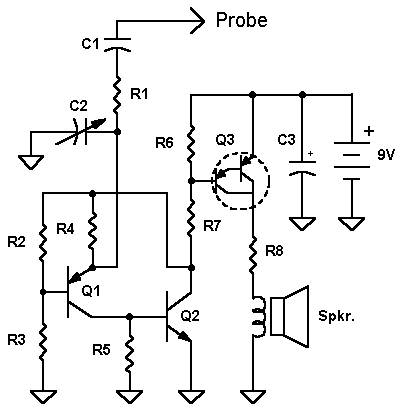
The probe should be built into a metal box so that one hand makes good contact to the circuit ground. My beeper is built into an Altoids Mint box with the paint sanded off (use steel wool). Leave the paint if you like the artwork! I prefer the scientific motif. The open beeper is shown below. The thin metal box is easily soldered so all ground connections are directly soldered to the box. Also note the strip of PCB material soldered into place next to the battery to form a simple battery holder. A strip of foam pushes on the battery when the lid is closed. There is a single small hole for the sound under the speaker.
Parts substitution is risky! The resistor values are selected to barely turn on the transistors to conserve battery power. The transistors must have very high gain and good low current properties. The MPS-A18 is a very high gain transistor with excellent gain at very low currents. The capacitors are not particularly critical but the trimmer might require a little care. The trimmer is adjusted until the beeping just stops and only a very weak squeal is heard when a 2.2 pF capacitor is touched to the probe. Attempting more sensitivity risks excessive battery current. Less sensitivity is fine if the probe is not to be used on very low values.
The Curious C-Beeper will become indispensable in virtually no time! It quickly matches capacitors and trimmers making it an indispensable RF tool. Forget the capacitance meter when matching parts from the parts bin - the "fingers as conductors" feature makes the C-Beeper super-fast when searching for that perfect value. It easily detects tiny variations when the capacitor is heated or cooled allowing quick discrimination between NPOs and "Stable" dielectric. General purpose and temperature compensating dielectric are quite easy to spot. The C-Beeper makes an excellent cable fault locator - the end with the open will have less capacitance and beep at a much higher pitch. A break along an unshielded bundle can be spotted by grabbing the bundle at various points while listening for the capacitance change. Find the bad bulb in a string of Christmas lights faster than ever! Identify which wire is which at the end of a bundle without stripping back the insulation. Identify traces on unpopulated PCBs right through solder mask. Grade feedthrough capacitors, identify varicap diodes, instantly determine if a power rectifier is a Schottky or not, etc.
Make a small flat plate electrode and line voltage electric fields may be detected. Follow wires behind walls and ceilings or determine if wires are without touching them. The C-Beeper's tone is modulated by the AC voltage causing a warbling sound. Circuits with lamp dimmers, solid-state switches or fluorescent bulbs are especially easy to detect due to the harmonics on the line.